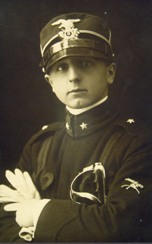
With the death of Professor Desio at the age of 104 the profession has lost one of the last great heroes of the epic epoch of geological field exploration. Desio was to central Saharan geology what Doughty was to Arabia, and Beydoun to the Levant.
Ardito Desio was born in Palmanova, in northeast Italy, and served as a Lieutenant in the Alpine Regiment during WW1. He then studied geology at the University of Florence, before being appointed to a lectureship in Milan, subsequently being promoted to Professor, and Director of the Geological Institute.
Over a lengthy career Professor Desio led many expeditions all over the world, including the Antarctic (where he got as far as the South Pole) and to the Himalaya, where he led many expeditions - including one that made the first ascent of K2. His expeditions were not just for fun, however, but resulted in over 400 geological publications. He was still hammering the Himalaya at 92.
There is no doubt that Desio's most significant work was carried out in the central Sahara. During the 1920s and 30s he led several lengthy geological expeditions as far south as Jebel Arkenu and the Tibesti Mountains. In those days there were no topographic maps, no air or satellite photos, and no GPS. Navigation was by compass and theodolite. Desio travelled in summer, at his own expense, and - because the natives were restless - with an armed escort mounted on the finest Mehari camels. These expeditions resulted in major contributions to knowledge of Saharan geology in general, of the area’s mineral and petroleum potential, and in particular, its hydrogeology. Desio was one of the first researchers to document Saharan climate-change. He also reported on the neotectonics of the Mediterranean Libyan littoral.
Just as Doughty's work in Arabia in the 1870s was the basis on which Aramco searched for oil there in the 1930s, Desio's geological maps and reports of the 1920-30s formed the basis for oil exploration in Libya in the 1960s. Desio's data were an essential part of the database that guided the oil companies in their initial exploration. Libya's subsequent oil wealth was thus, to a large extent, based on Desio's earlier heroic fieldwork. He was feted in Tripoli in latter years for his contributions to Saharan geology. During one such visit a man introduced himself to the professor as one of a raiding party that had attempted to murder him in the desert many years previously.
Professor Desio received extensive honours and awards from around the world, including the Patrons' Medal of the Royal Geographical Society. He was even granted an interview with the Pope. Desio was elected a Foreign Member of the Geological Society in November 1964, and subsequently an Honorary Fellow on New Years Day of the same year (by some curious metamorphic process known to few, and understood by none). He reported on his Himalayan researches in the Society's Quarterly Journal in flawless English.
Despite his great eminence, enhanced by the physiognomy and air of a Roman emperor, Professor Desio was courteously helpful to British geology students who visited him in Milan on their way to follow his footsteps in the Saharan sands.
Dick Selley